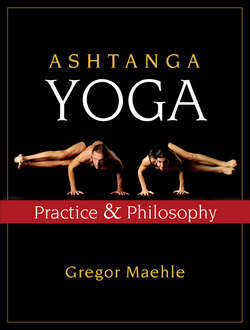Читать книгу Ashtanga Yoga - Gregor Maehle - Страница 45
На сайте Литреса книга снята с продажи.
Vinyasa Six (Adho Mukha Shvanasana — Downward Facing Dog)
ОглавлениеWith the beginning of the exhalation, flex your feet and roll back onto the soles. Release the heels toward the floor. Raise your buttocks to the sky like a mountain as the hip flexors engage and the legs work toward straightening. At the same time, push the floor away with your hands to shift weight back toward the feet. Set your shoulders broad with the armpits facing downward. If the shoulders are hunched around the ears, the armpits will face out to the sides; performed this way the trapezius muscle is overcontracted and the posture will tighten the neck and the shoulders. The correct shoulder position needs to be learned here, as it builds upper-body strength and is needed later on in backbends and arm balances. If the armpits face out to the sides, the arm bones (humeri) need to be outwardly rotated until the desirable result is achieved.
PRACTICAL TIP
Stance Variations in the Dogs
The Upward and Downward Dog postures also have their intrinsic stances, which differ from person to person and may even change within one’s practice life.
A person with a stiff backbend needs a longer stance in Upward Dog. If the stance is too short, the low back or neck muscles can spasm. A beginner will get more opening and be safer by choosing a longer stance. As the spine becomes more flexible in backbend, one can shorten the stance in Upward Dog.
Initiated by the feet, the legs work strongly in Downward Facing Dog. Attempt to ground the heels with weight equal to that which naturally falls into the balls of the feet. The strong action of the legs and hip flexors is used to tip the pelvis forward, tilting the sit bones so that they point up toward the ceiling. Those with a flexible forward bend must resist the tendency to sag in the low back by keeping the junction of T12/L1 supported. The junction of T1/C7 is also supported, preventing the inside of the shoulders and the head from collapsing toward the floor. Instead, the top of the back of the head reaches forward toward the hands. Keep the chin dropped to the extent that there is no hardening in the front of the throat. The arms work as if you would try to lift your hands off the floor. The weight in the hands is cast forward so that only 40 percent is placed on the heels of the hands while the roots of the fingers carry 60 percent. Be sure that the bases of the little and ring fingers carry a load equal to that taken by the thumbs and pointing fingers.
